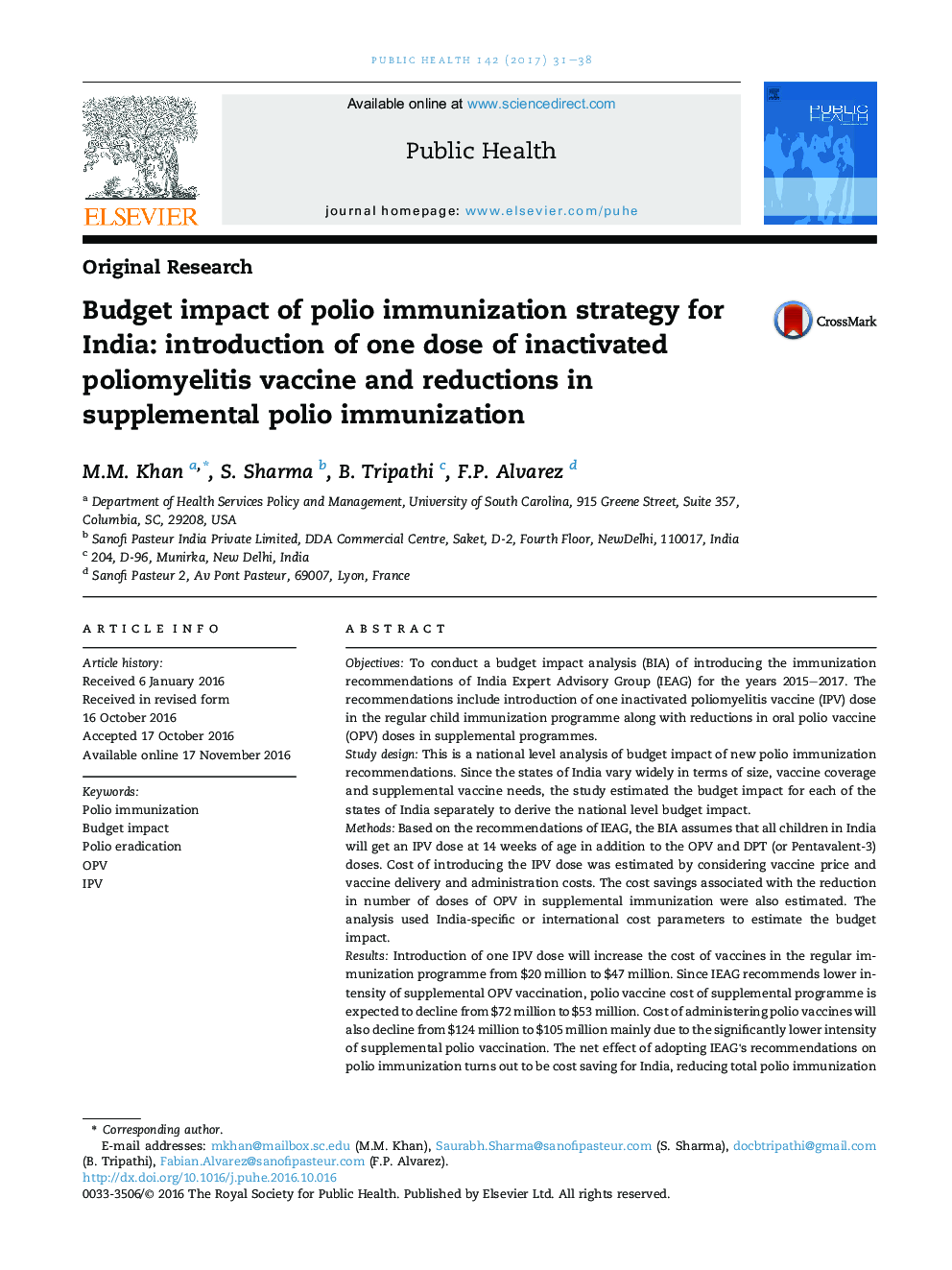| کد مقاله | کد نشریه | سال انتشار | مقاله انگلیسی | نسخه تمام متن |
|---|---|---|---|---|
| 5122759 | 1487201 | 2017 | 8 صفحه PDF | دانلود رایگان |
- Budget impact for India for switching from oral polio vaccine (OPV)-based polio immunization to one inactivated poliomyelitis vaccine (IPV) based strategy was estimated.
- Introduction of one dose of IPV will not be cost increasing due to concurrent reductions in supplemental immunizations.
- The new strategy will lower total expenditure on polio immunization by $4.1 million in 2015 and $10 million in 2017.
- Vaccine procurement cost will increase from $20 to $47 million but vaccine administration cost will reduce by $20 million.
- Open-vial policy can reduce OPV wastage rate from 47% to 10%, which will lower cost by an additional $26 million.
ObjectivesTo conduct a budget impact analysis (BIA) of introducing the immunization recommendations of India Expert Advisory Group (IEAG) for the years 2015-2017. The recommendations include introduction of one inactivated poliomyelitis vaccine (IPV) dose in the regular child immunization programme along with reductions in oral polio vaccine (OPV) doses in supplemental programmes.Study designThis is a national level analysis of budget impact of new polio immunization recommendations. Since the states of India vary widely in terms of size, vaccine coverage and supplemental vaccine needs, the study estimated the budget impact for each of the states of India separately to derive the national level budget impact.MethodsBased on the recommendations of IEAG, the BIA assumes that all children in India will get an IPV dose at 14 weeks of age in addition to the OPV and DPT (or Pentavalent-3) doses. Cost of introducing the IPV dose was estimated by considering vaccine price and vaccine delivery and administration costs. The cost savings associated with the reduction in number of doses of OPV in supplemental immunization were also estimated. The analysis used India-specific or international cost parameters to estimate the budget impact.ResultsIntroduction of one IPV dose will increase the cost of vaccines in the regular immunization programme from $20 million to $47 million. Since IEAG recommends lower intensity of supplemental OPV vaccination, polio vaccine cost of supplemental programme is expected to decline from $72 million to $53 million. Cost of administering polio vaccines will also decline from $124 million to $105 million mainly due to the significantly lower intensity of supplemental polio vaccination. The net effect of adopting IEAG's recommendations on polio immunization turns out to be cost saving for India, reducing total polio immunization cost by $6 million. Additional savings could be achieved if India adopts the new policy regarding the handling of multi-dose vials after opening. Introduction of three doses of IPV with the existing polio immunization schedule will increase the budget requirement by $102 million but replacing OPV doses with IPV will increase the budget by about $59 million. Discontinuation of supplemental OPV immunization with replacement of OPV by IPV will reduce the Government of India's (GOI) polio immunization budget by $99 million.ConclusionAlthough the overall cost of polio programme will decline with the adoption of IEAG's recommendations, state-level costs will vary widely. In states like Kerala, Karnataka, Uttar Pradesh and Andhra Pradesh, cost of polio immunization will increase while in Punjab and Jharkhand the costs will remain more or less constant. Significant cost reductions will happen in states with high intensity of supplemental polio immunizations (Bihar, Haryana and Delhi). The cost of procuring polio vaccines will more than double from $20 million to about $47 million requiring allocation of additional foreign exchanges. In some states (like Bihar), the decline in polio-related employment will be very high requiring reallocation of personnel from polio to other programmes.
Journal: Public Health - Volume 142, January 2017, Pages 31-38
